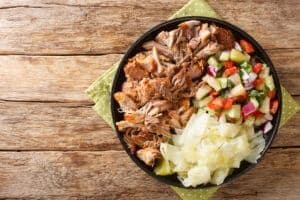By Michelle Wohl

Kalua Pork
Hawaiʻi’s food scene is as rich and diverse as its landscapes. A true melting pot of Pacific, Asian, and Western influences, the islands offer dishes that reflect centuries of migration, cultural blending, and local innovation. Whether you’re a foodie, an adventurer, or just a curious visitor, these five iconic dishes are more than meals—they’re an experience. Here’s what to try, and where to find the best bites on Oʻahu.
What It Is:
Poke (pronounced poh-keh) means “to slice” or “cut crosswise into pieces” in Hawaiian. Traditionally, it’s fresh, cubed raw fish—most often ahi (yellowfin tuna)—marinated in soy sauce, sesame oil, seaweed, green onions, and chili pepper. But poke has evolved into something wonderfully diverse. Today, you’ll find creative variations with salmon, tofu, octopus (tako), avocado, edamame, mango, or even kimchi, making each bowl a customizable flavor bomb.
Where to Get It:
Head to Ono Seafood on Kapahulu Avenue in Honolulu. This hole-in-the-wall joint may not look fancy, but locals and in-the-know visitors line up for their unbelievably fresh poke. The spicy ahi and shoyu poke are fan favorites—perfectly seasoned and melt-in-your-mouth tender. Grab your poke bowl and head to nearby Kapiʻolani Park or Queen’s Beach for a picnic under the palms. Few things beat poke by the ocean with Diamond Head as your backdrop.
Insider Tip:
Many locals judge a poke spot by the freshness of the fish and the balance of marinade. Ono Seafood delivers on both fronts—and their generous portions make them a winner for both quality and value.
What It Is:
Loco moco is the ultimate Hawaiian comfort food: a mountain of white rice topped with a juicy hamburger patty, a runny fried egg, and a ladle of savory brown gravy. It’s rich, hearty, and a little messy—in the best way possible. Invented in Hilo on the Big Island in the 1940s, this dish has fueled generations of locals and now wins over visitors looking for a satisfying post-surf meal or hangover cure.
Where to Get It:
There’s no better place to dive in than Rainbow Drive-In in Waikīkī. This beloved institution has been serving up plate lunches since 1961 and feels like a nostalgic time capsule of old Hawaiʻi. Order your loco moco and grab an outdoor table alongside construction workers, families, and fellow travelers. You’ll leave full—and maybe just a little in love with Hawaiian diner culture.
Why It’s a Must-Try:
Beyond the savory satisfaction, loco moco captures the spirit of local ingenuity—simple ingredients elevated by the island’s multicultural culinary heritage.
What It Is:
Imagine a doughnut without a hole, fried to golden perfection and rolled in sugar. That’s a malasada—a Portuguese-inspired treat brought to Hawaiʻi by plantation workers in the 19th century. Some are filled with luscious creams like haupia (coconut), chocolate, or lilikoi (passion fruit). Others are served plain, warm and pillowy straight from the fryer.
Where to Get It:
You simply cannot visit Honolulu without stopping at Leonard’s Bakery on Kapahulu Avenue. Since 1952, this legendary spot has been slinging malasadas to sweet-toothed crowds. Try the classic sugar-coated first, then go wild with the custard-filled flavors. Warning: one is never enough.
Pro Tip:
Get there early to beat the crowds, and eat your malasadas fresh—they’re at their best within minutes of being made.
What It Is:
Kalua pig is Hawaiian-style pulled pork, traditionally cooked in an imu—an underground oven lined with hot stones and banana leaves. The result? Smoky, tender meat with a whisper of earthiness that can only come from this ancient cooking method. While many modern versions are oven-roasted with liquid smoke, the best still honor the slow, smoky roots.
Where to Get It:
For a truly authentic plate, head to Highway Inn, with locations in Kakaʻako and Waipahu. This family-owned restaurant has been serving Hawaiian classics since 1947. Their kalua pig is moist, flavorful, and best enjoyed alongside lomi salmon, chicken long rice, or a scoop of poi for the full Hawaiian plate lunch experience.
Cultural Note:
Kalua pig is a cornerstone of traditional Hawaiian feasts (lūʻau), often reserved for special occasions. Eating it is not just about taste—it’s about honoring centuries of tradition.
What It Is:
Not to be confused with a snow cone, Hawaiian shave ice is finely shaved—think powdery snow—and drenched in vibrant syrups. It’s light, refreshing, and fully customizable. Popular extras include a scoop of vanilla ice cream at the bottom, sweetened condensed milk drizzled on top (snow cap), and chewy mochi balls or azuki beans for added texture.
Where to Get It:
Drive up to Matsumoto Shave Ice in Haleʻiwa on the North Shore. This iconic shop has been cooling off surfers and tourists since 1951. The rainbow combo—strawberry, lemon, and pineapple—is a classic, but you can mix and match flavors like guava, lychee, or li hing mui (salty plum). Add the extras—you won’t regret it.
A Taste of Aloha:
Nothing captures the joy of a beach day quite like a colorful shave ice under the Hawaiian sun. It’s a treat for kids and grown-ups alike, and a delicious way to beat the heat.
These aren’t just foods—they’re stories on a plate. They reflect the many cultures that have shaped Hawaiʻi over generations: Polynesian voyagers, Asian immigrants, Portuguese settlers, and American influences. Eating them isn’t just a pleasure—it’s a way to connect with the island’s past and present.
So whether you’re enjoying poke on the beach, savoring loco moco in a diner, or cooling down with shave ice after a North Shore adventure, you’re doing more than just feeding your body—you’re feeding your aloha spirit.
Join our newsletter for travel inspiration, insider tips and the latest island stories.
By subscribing, you agree to receive emails from Hawaii.com. You can unsubscribe anytime. See our Privacy Policy.